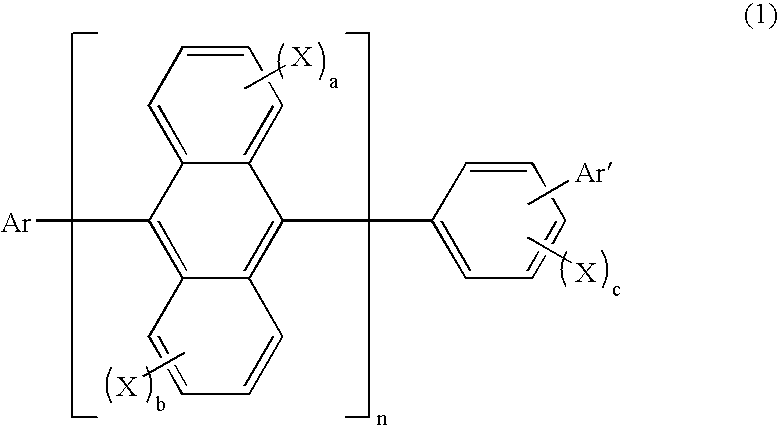Organic electroluminescence device and anthracene derivative
an electroluminescence device and anthracene technology, applied in the field of organic electroluminescence devices and anthracene derivatives, can solve the problems of not being able to actually synthesize compounds as light emitting materials, and achieve the effect of great light emission efficiency
- Summary
- Abstract
- Description
- Claims
- Application Information
AI Technical Summary
Benefits of technology
Problems solved by technology
Method used
Image
Examples
synthesis example 2
Synthesis of 2-(4-bromophenyl)naphthalene
[0117] Under the atmosphere of argon, a solution prepared by dissolving 7.1 g of 2-naphthaleneboric acid (manufactured by TOKYO KASEI Co., Ltd.), 12.9 g of 4-iodobromobenzene (manufactured by TOKYO KASEI Co., Ltd.), 0.6 g of tetrakis(triphenylphosphine)palladium(0) (manufactured by TOKYO KASEI Co., Ltd.) and 12.7 g of sodium carbonate (manufactured by HIROSHIMA WAKO Co., Ltd.) into 60 ml of water was placed into a 300 ml flask, and the resultant mixture was stirred for 24 hours while being heated under the refluxing condition. After the reaction was completed, the reaction mixture was cooled to the room temperature, and formed crystals were separated by filtration. The obtained crystals were recrystallized from toluene, and 9.0 g of crystals were obtained
[0118] Since m / z=284 in FD-MS of the obtained compound, which corresponded to C16H11Br=283, the compound was identified to be 2-(4-bromophenyl)naphthalene (the yield: 77%).
synthesis example 3
Synthesis of 3-(4-bromophenyl)fluoranthene
[0119] Under the atmosphere of argon, 62 g of fluoranthene and 250 ml of dehydrated DMF (manufactured by HIROSHIMA WAKO Co., Ltd.) were placed into a 500 ml flask and heated at 80° C. After the material was dissolved, 60 g of N-bromosuccinimide (manufactured by HIROSHIMA WAKO Co., Ltd.) was added at 50° C., and the resultant mixture was stirred for 2 hours. After the reaction was completed, the reaction solution was poured into 500 ml of purified water, and formed crystals were separated by filtration. The separated crystals were purified in accordance with the column chromatography, and 10.5 g of crystals were obtained.
[0120] Under the atmosphere of argon, 10.0 g of the crystals obtained above, 120 ml of dehydrated ether (manufactured by HIROSHIMA WAKO Co., Ltd.) and 120 ml of dehydrated toluene (manufactured by HIROSHIMA WAKO Co., Ltd.) were placed into a 500 ml flask, and the resultant mixture was cooled at −0.64° C. in a dry ice bath. ...
synthesis example 4
Synthesis of 10-(3-fluoranthenyl)anthracene-9-boric acid
[0123] Under the atmosphere of argon, a solution prepared by dissolving 7.85 g of 3-fluorantheneboric acid, 6.84 g of 9-bromoanthracene (manufactured by TOKYO KASEI Co., Ltd.), 0.6 g of tetrakis-(triphenylphosphine)palladium(0) (manufactured by TOKYO KASEI Co., Ltd.), 50 ml of toluene (manufactured by HIROSHIMA WAKO Co., Ltd.) and 8.5 g of sodium carbonate (manufactured by HIROSHIMA WAKO Co., Ltd.) into 50 ml of water was placed into a 300 ml flask, and the resultant mixture was stirred for 24 hours while being heated under the refluxing condition. After the reaction was completed, the reaction mixture was cooled to the room temperature, and formed crystals were separated by filtration. The obtained crystals were recrystallized from toluene, and 4.6 g of crystals were obtained
[0124] Under the atmosphere of argon, 4.5 g of the crystals obtained above and 100 ml of dehydrated DMF (manufactured by HIROSHIMA WAKO Co., Ltd.) were ...
PUM
| Property | Measurement | Unit |
|---|---|---|
| Time | aaaaa | aaaaa |
| Time | aaaaa | aaaaa |
| Time | aaaaa | aaaaa |
Abstract
Description
Claims
Application Information
 Login to View More
Login to View More - R&D
- Intellectual Property
- Life Sciences
- Materials
- Tech Scout
- Unparalleled Data Quality
- Higher Quality Content
- 60% Fewer Hallucinations
Browse by: Latest US Patents, China's latest patents, Technical Efficacy Thesaurus, Application Domain, Technology Topic, Popular Technical Reports.
© 2025 PatSnap. All rights reserved.Legal|Privacy policy|Modern Slavery Act Transparency Statement|Sitemap|About US| Contact US: help@patsnap.com



